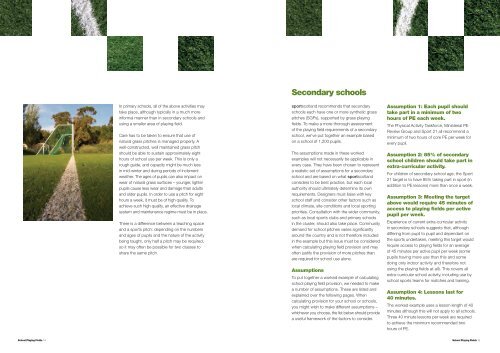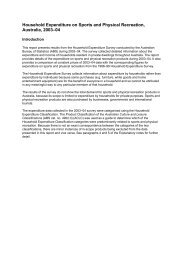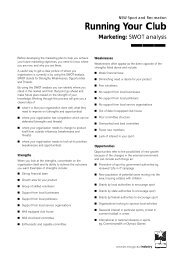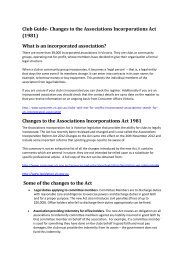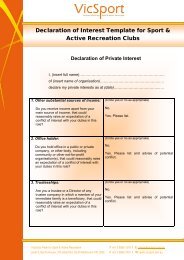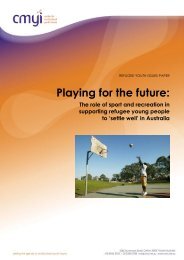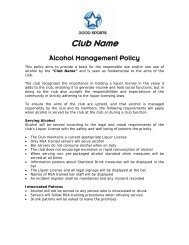School Playing Fields: Planning and Design Guidance - VicSport
School Playing Fields: Planning and Design Guidance - VicSport
School Playing Fields: Planning and Design Guidance - VicSport
You also want an ePaper? Increase the reach of your titles
YUMPU automatically turns print PDFs into web optimized ePapers that Google loves.
In primary schools, all of the above activities maytake place, although typically in a much moreinformal manner than in secondary schools <strong>and</strong>using a smaller area of playing field.Care has to be taken to ensure that use ofnatural grass pitches is managed properly. Awell-constructed, well maintained grass pitchshould be able to sustain approximately eighthours of school use per week. This is only arough guide, <strong>and</strong> capacity might be much lessin mid-winter <strong>and</strong> during periods of inclementweather. The ages of pupils can also impact onwear of natural grass surfaces – younger, lighterpupils cause less wear <strong>and</strong> damage than adults<strong>and</strong> older pupils. In order to use a pitch for eighthours a week, it must be of high quality. Toachieve such high quality, an effective drainagesystem <strong>and</strong> maintenance regime must be in place.There is a difference between a teaching space<strong>and</strong> a sports pitch: depending on the numbers<strong>and</strong> ages of pupils <strong>and</strong> the nature of the activitybeing taught, only half a pitch may be required,so it may often be possible for two classes toshare the same pitch.Secondary schoolssportscotl<strong>and</strong> recommends that secondaryschools each have one or more synthetic grasspitches (SGPs), supported by grass playingfields. To make a more thorough assessmentof the playing field requirements of a secondaryschool, we’ve put together an example basedon a school of 1,200 pupils.The assumptions made in these workedexamples will not necessarily be applicable inevery case. They have been chosen to representa realistic set of assumptions for a secondaryschool <strong>and</strong> are based on what sportscotl<strong>and</strong>considers to be best practice, but each localauthority should ultimately determine its ownrequirements. <strong>Design</strong>ers must liaise with keyschool staff <strong>and</strong> consider other factors such aslocal climate, site conditions <strong>and</strong> local sportingpriorities. Consultation with the wider community,such as local sports clubs <strong>and</strong> primary schoolsin the cluster, should also take place. Communitydem<strong>and</strong> for school pitches varies significantlyaround the country <strong>and</strong> is not therefore includedin the example but this issue must be consideredwhen calculating playing field provision <strong>and</strong> mayoften justify the provision of more pitches thanare required for school use alone.AssumptionsTo put together a worked example of calculatingschool playing field provision, we needed to makea number of assumptions. These are listed <strong>and</strong>explained over the following pages. Whencalculating provision for your school or schools,you might wish to make different assumptions –whichever you choose, the list below should providea useful framework of the factors to consider.Assumption 1: Each pupil shouldtake part in a minimum of twohours of PE each week.The Physical Activity Taskforce, Ministerial PEReview Group <strong>and</strong> Sport 21 all recommend aminimum of two hours of core PE per week forevery pupil.Assumption 2: 85% of secondaryschool children should take part inextra-curricular activity.For children of secondary school age, the Sport21 target is to have 85% taking part in sport (inaddition to PE lessons) more than once a week.Assumption 3: Meeting the targetabove would require 45 minutes ofaccess to playing fields per activepupil per week.Experience of current extra-curricular activityin secondary schools suggests that, althoughdiffering from pupil to pupil <strong>and</strong> dependant onthe sports undertaken, meeting this target wouldrequire access to playing fields for an averageof 45 minutes per active pupil per week (somepupils having more use than this <strong>and</strong> somedoing only indoor activity <strong>and</strong> therefore notusing the playing fields at all). This covers allextra-curricular school activity, including use byschool sports teams for matches <strong>and</strong> training.Assumption 4: Lessons last for40 minutes.The worked example uses a lesson length of 40minutes although this will not apply to all schools.Three 40 minute lessons per week are requiredto achieve the minimum recommended twohours of PE.<strong>School</strong> <strong>Playing</strong> <strong>Fields</strong> 14<strong>School</strong> <strong>Playing</strong> <strong>Fields</strong> 15


